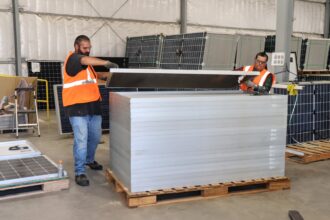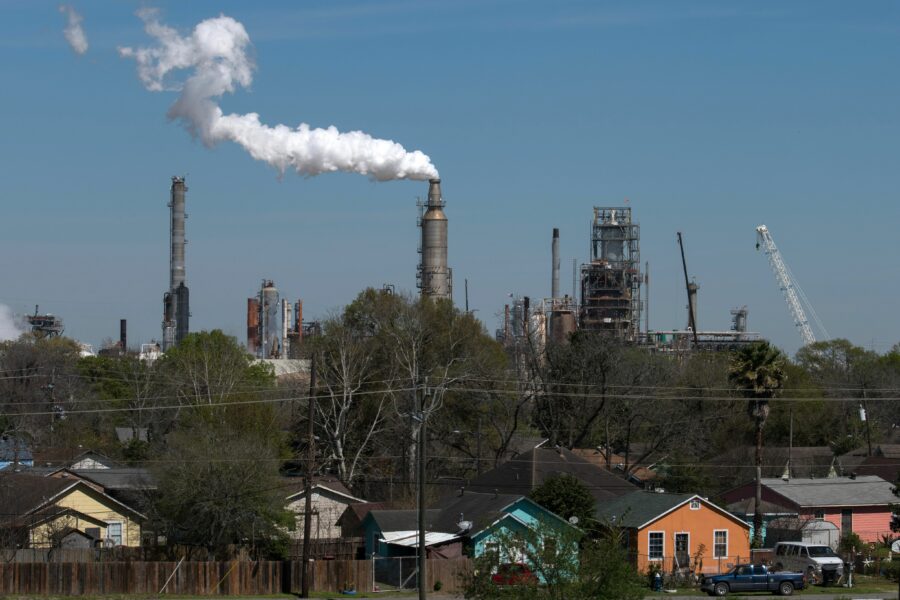PHILADELPHIA—President Joe Biden traveled to a marine terminal here on Friday to announce billions in funding for new clean hydrogen projects that he said would help the nation meet its climate goals while generating thousands of new high-quality jobs. Surrounded by lines of shipping containers on a dock along the Delaware River, Biden positioned the program as a critical piece of his economic and climate platforms.
“The investment we’re making today will be for our kids and grandkids,” Biden said. “Today’s announcement is transformational.”
The announcement included up to $7 billion in grants for seven hydrogen “hubs” across the country, including two in Pennsylvania, and marks the biggest step yet in a controversial pillar of the president’s climate agenda.
Many advocates and policy experts say a new clean hydrogen industry could, if designed well, play an important role in cutting climate pollution from sectors of the economy without good low-carbon alternatives, like steel making, fertilizer production and aviation. But some of those same experts warn that, without proper guardrails, expanded use of hydrogen could also undercut climate goals and extend reliance on fossil fuels while costing the government potentially hundreds of billions of dollars in subsidies.
“It’s really essential that we get it right,” said Morgan Rote, director of U.S. climate policy at the Environmental Defense Fund. She added that this week’s hub announcement, together with a tax credit enacted by Congress last year, will throw a tremendous sum of public money at the technology, “and there are a lot of ways that we could go off the rails.”
Critically, Rote and other experts say, the department has yet to make enough information public about the hydrogen hubs to determine whether those needed guardrails are in place. It is even possible, according to one analysis, that some of the hubs could fail to meet the Energy Department’s own definition of “clean hydrogen.”
“They seem to have the right goals and objectives,” Rote said of the department. “The extent to which the projects actually align with that I think remains to be seen.”
The seven hubs are scattered across the country, backed by a combination of industries, universities and local and state governments, and will aim to produce roughly 3 million metric tons of hydrogen per year by 2030, or one-third of the Biden administration’s goal. The administration said the hubs will eventually eliminate 25 million metric tons of climate pollution per year, equivalent to the emissions of about 5.5 million cars, but it released few details that would allow experts to assess that estimate.
While the sum of emissions cuts is relatively small, at less than 1 percent of the nation’s total of more than 6 billion metric tons annually, the hubs are meant to test the technology and provide a model for a larger industry. If that effort is successful, the new production tax credit could provide far more support to companies that build clean hydrogen projects, tens or even hundreds of billions of dollars over a decade.
The answer to whether hydrogen will help meet climate goals will depend on a set of questions, some of them highly technical, about how the fuel is produced and where it’s used.
Hydrogen burns without generating climate pollution, meaning it could replace fossil fuels in a number of applications. But producing it requires pulling it out of other molecules—generally either methane from natural gas, or water. Either process requires large amounts of energy.
To make it “clean,” that energy has to come from a low-emissions source, like wind or solar power. Many oil and gas companies are also trying to use equipment that would capture and store the carbon dioxide emissions that are released when hydrogen is separated from methane gas.
Of the seven hubs announced, at least three would use natural gas and carbon capture. Many scientists and environmental advocates have warned that making this so-called “blue hydrogen” could fail to meaningfully reduce emissions and could even, under some circumstances, increase climate pollution. One problem comes from leaks of natural gas, which is primarily methane, a greenhouse gas that traps 86 times more heat than carbon dioxide over a 20-year period. If the leaks from drilling and delivering the natural gas to the hydrogen plant are too high, they can outweigh the benefits of capturing carbon emissions and replacing fossil fuels with hydrogen.
Another question is whether companies will be able to achieve the success they claim they can with carbon capture. So far, there have been no commercial-scale projects that remove the high levels of CO2 that would be needed to make blue hydrogen truly qualify as clean.
In a report published last month, the Institute for Energy Economics and Financial Analysis, which has been critical of carbon capture technology, warned that the Energy Department’s own modeling for emissions from blue hydrogen was faulty. One of the problems they identified was that the department’s modeling assumed that methane leaks were significantly lower than the majority of scientific studies suggest.
If projects use these default assumptions, rather than supplying information about leaks specific to their projects, it could make projects seem like they meet the threshold of “clean” when their true emissions are significantly higher.
The Energy Department declined to answer a question about whether it would require applicants to provide information about methane leaks specific to their projects.
The department’s publicly-available information for applicants said it “encouraged” projects to use project-specific data when estimating their greenhouse gas emissions, but did not require them to do so, and said that it would rely on the defaults in its models absent specific information.
Even if projects are able to clean up methane leaks and capture nearly all the carbon dioxide they pollute, they will still spur more drilling and hydraulic fracturing for natural gas, processes that have been tied to numerous health impacts for people living near development, including higher rates of certain cancers.
One of the largest blue hydrogen proposals has come from ExxonMobil, which said it plans to build a major blue hydrogen plant at its Baytown refinery and petrochemical complex near Houston. Exxon is part of a consortium of companies, including Chevron, behind a Gulf Coast hydrogen hub that was awarded up to $1.2 billion by the Energy Department. Oil companies, which have huge natural gas assets, have been big supporters of the idea of government investment in hydrogen technology, which could give them a market for their products in a climate-constrained future.
The hub could be particularly problematic when it comes to greenhouse gas emissions because some of the country’s highest rates of methane leaks are in the nearby Permian Basin.
A spokesperson for the Gulf Coast hub did not respond to questions for this article about where it will source its natural gas, what its expected rates of methane leaks would be or whether it would provide specific data to the Energy Department or rely instead on the national average default. The project has said it will also produce hydrogen using renewable power.
Many local environmental groups, however, are unhappy about the news.
We are “extremely disappointed with today’s hydrogen hubs announcement,” said Elida Castillo, program director for Chispa Texas, an offshoot of the League of Conservation Voters, in a statement. “While we appreciate an acknowledgement of the climate crisis, we cannot support initiatives that benefit the same industries that got us here and for questionable emissions reductions. Our frontline communities, who already bear the brunt of the costs to our health and environment, should be the recipients of that $7 billion instead—Congress misdirected these taxpayer dollars.”
A group of companies forming an Appalachian hydrogen hub was awarded nearly $1 billion and will also use carbon capture and natural gas. Arria Hines, a spokesperson for hub, said it would achieve “production-weighted average” of 1.15 kilograms of carbon dioxide-equivalent emissions for each kilogram of hydrogen it produces. That figure could include some amount of hydrogen produced with renewable energy, she said.
That would place it well below the department’s definition of “clean,” or 4 kilograms of CO2-equivalent per kilogram of hydrogen. It would also place it well below the department’s estimates of what a blue hydrogen project should be expected to achieve, however, and would imply a remarkably low rate of methane leaks and near total carbon capture rates.
Hines declined to say whether the hub’s estimate would be based on direct measurements, rather than modeling, or whether it would make its methodology available to the public and have it verified by an independent party, all of which are considered best practices.
Sean O’Leary, a senior researcher at the Ohio River Valley Institute, an advocacy group that has been critical of hydrogen and carbon capture, said the Appalachian hub “is neither the most effective nor the lowest cost way” to reduce emissions.
The Biden administration said that two-thirds of the hub money will go towards “green hydrogen,” which is made using renewably-generated electricity. Most climate advocates argue this is a better use of funds and eventually should be the only kind of hydrogen produced. But even green hydrogen has its risks.
If projects divert clean energy from the electric grid, for example, they can increase demand that would be met with fossil fired power plants and actually drive emissions higher.
Two projects also plan to use electricity from nuclear power to make hydrogen.
Beyond the type of production, the use of hydrogen can be just as important. Some studies have shown that using hydrogen to heat homes, for example, or blending it into natural gas pipelines to burn in power plants, would be far less effective than using electricity generated by wind or solar power and could drive up energy costs.
The EPA has proposed rules for cutting climate pollution from the power sector that would allow companies to rely on fueling their plants with hydrogen, and the hubs could help shape how that effort develops.
Four of the seven hubs say they plan to use hydrogen in the power sector, while two mention using it for heating.
Beyond the climate implications, the hydrogen hubs will be a test for the Biden administration’s stated goals of using a clean energy transition to help improve the lives of people who have suffered the most from polluting industries and lost jobs in the fossil fuel sector.
Keep Environmental Journalism Alive
ICN provides award-winning climate coverage free of charge and advertising. We rely on donations from readers like you to keep going.
Donate NowThe Appalachian hub, for example, said it would create more than 21,000 jobs, many of them in coal communities. But many community groups say they have been left out of the process of selecting winners for the hub awards.
“The amount of community engagement and community protections are going to be really crucial to the projects’ success,” Rote said. “Without those, projects could create really unfair health and environmental impacts. There’s potential for worsened air pollution, for interrupting existing water resources.”
So far, Rote said it is impossible to say whether civil society groups will get enough information from the department to meaningfully affect the hubs’ development before it’s too late.
The announcement of the winners is just a first step. The department will now enter into negotiations with the hubs and could rescind those awards depending on the outcome. The department has said it will release more information as the negotiations proceed.
“I’m sort of giving them the benefit of the doubt and assuming that that information is forthcoming for people to be able to engage,” Rote said. “They know what’s needed.”











